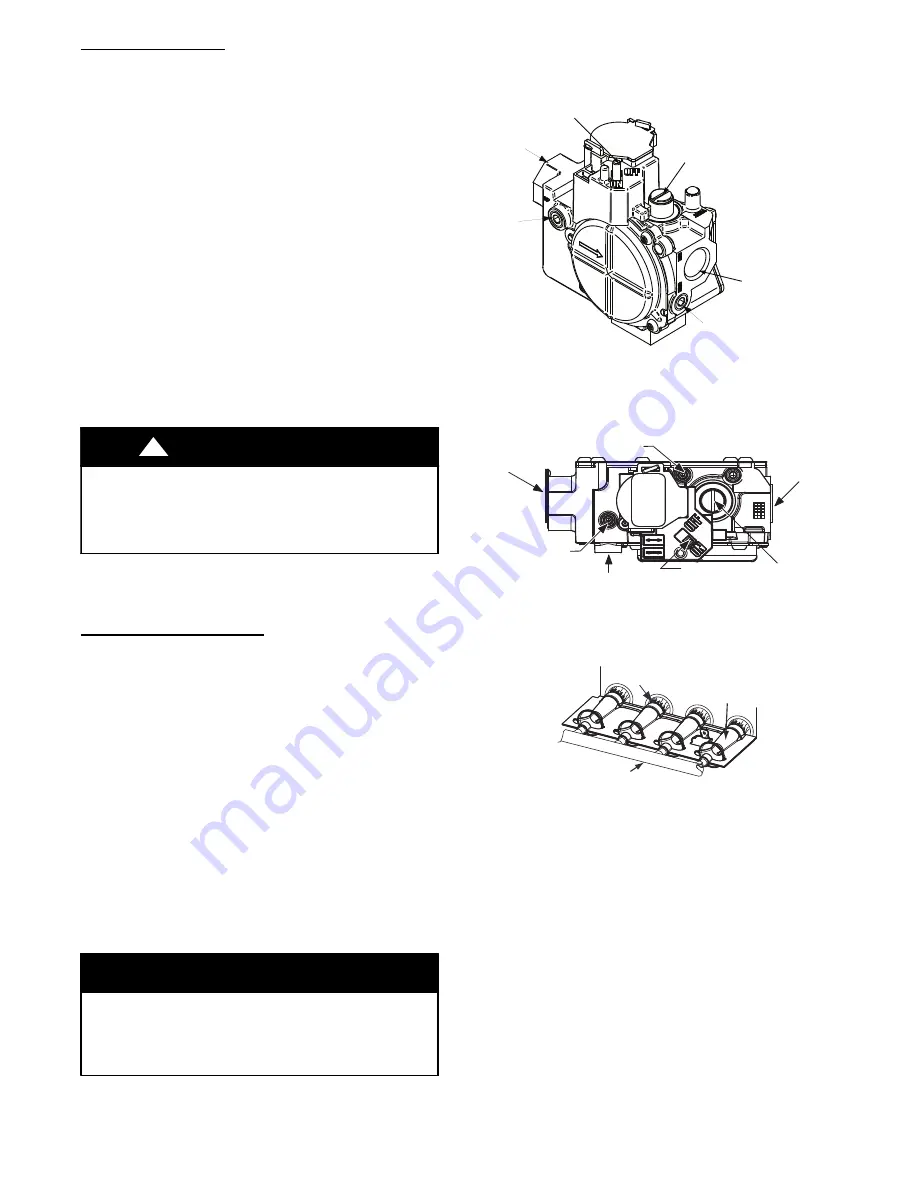
440 01 6201 00B
55
Specifications subject to change without notice.
Check Inlet Gas Pressure
The inlet gas pressure must be checked with the furnace operating
in maximum heat. This is necessary to make sure the inlet gas
pressure does not fall below the minimum pressure of 4.5 in. w.c.
1. Make sure the gas supply is turned off to the furnace and at
the electric switch on the gas valve.
2. Loosen set screw on inlet tower pressure tap no more than
one full turn with a 3/32--in. hex wrench or remove the
1/8--in. NPT plug from the inlet pressure tap on the gas
valve.
3. Connect a manometer to the inlet pressure tap on gas valve.
4. Turn on furnace power supply.
5. Turn gas supply manual shutoff valve to ON position.
6. Turn furnace gas valve switch to ON position.
7. Jumper R and W thermostat connections at the furnace
control board.
8. When main burners ignite, confirm inlet gas pressure is
between 4.5 in. w.c. (1125 Pa) and 13.6 in. w.c. (3388 Pa).
9. Remove jumper across thermostat connections to terminate
call for heat. Wait until the blower off delay is completed.
10. Turn furnace gas valve electric switch to OFF position.
11. Turn gas supply manual shutoff valve to OFF position.
12. Turn off furnace power supply.
13. Remove manometer from the inlet pressure tap of the gas
valve.
FIRE HAZARD
Failure to follow this warning could result in personal injury,
death, and/or property damage.
Inlet pressure tap set screw must be tightened and 1/8--in. NPT
pipe plug must be installed to prevent gas leaks.
!
WARNING
14. Tighten set screw on inlet tower pressure tap with 3/32--in.
hex wrench, or if 1/8--in. NPT plug was removed, apply
pipe dope sparingly to end of plug and re--install in the gas
valve.
Adjust Manifold Pressure
1. Adjust manifold pressure to obtain proper gas input rate.
See Fig. 61.
a. Refer to the correct manifold pressure table for the appro-
priate model.
b. Turn gas valve ON/OFF switch to OFF.
c. Loosen set screw on manifold tower pressure tap no
more than one full turn with a 3/32--in. hex wrench, or
remove the 1/8 inch NPT plug from the manifold pres-
sure tap on the gas valve.
d. Connect a water column manometer or similar device to
manifold pressure tap.
e. Turn gas valve ON/OFF switch to ON.
f. Manually close blower door switch.
g. Jumper R and W thermostat connections on control to start
furnace. See Fig. 36.
h. Remove regulator adjustment cap from gas valve pressure
regulator and turn adjusting screw (3/16 or smaller flat--
tipped screwdriver) counterclockwise (out) to decrease in-
put rate or clockwise (in) to increase input rate. See Fig.
61.
DO NOT set manifold pressure less than 2.8--in. w.c. (697 Pa)
or more than 3.8 in. w.c. (947 Pa) for natural gas. If required
manifold pressure is outside this range, change main burner
orifices to obtain manifold pressure in this range.
NOTICE
i. When correct input is obtained, replace cap that conceals
gas valve regulator adjustment screws. Main burner flame
should be clear blue, almost transparent See Fig. 63.
ON/OFF Switch
Regulator Seal Cap
Regulator Adjustment
Regulator Seal Cap under Cap
1/2” NPT Outlet
1/8” NPT Manifold
Pressure Tap
1/8” NPT Inlet
Pressure Tap
1/2” NPT Inlet
SINGLE-STAGE
Representative drawing only, some models may vary in appearance.
A11153
Fig. 61 -- Gas Valve without Tower Pressure Ports
ON/OFF SWITCH
1/8” NPT INLET
PRESSURE TAP
REGULATOR SEAL CAP
(REGULATOR ADJ.
UNDER CAP)
1/2” NPT
OUTLET
MANIFOLD PRESSURE TAP
SET SCREW: 3/32” HEX HEAD
ACCEPTS 5/16” HOSE CONNECTION
OUTP
INP
VENT
1/2” NPT
INLET
INLET PRESSURE
TAP SET SCREW:
3/32” HEX HEAD
ACCEPTS 5/16”
HOSE CONNECTION
Representative drawing only, some models may vary in appearance.
A170118
Fig. 62 -- Gas Valve with Tower Pressure Ports
Burner Flame
Burner
Manifold
A11461
Fig. 63 -- Burner Flame
j. Remove jumper R to W.
2. Verify natural gas input rate by clocking meter.
NOTE
: Contact your HVAC distributor or gas supplier for metric
gas meter Tables, if required.
a. Turn off all other gas appliances and pilots served by the
meter.
b. Jumper R to W.
c. Run furnace for 3 minutes.
d. Measure time (in sec) for gas meter to complete one revolu-
tion and note reading. The 2 or 5 cubic feet dial provides
a more accurate measurement of gas flow.
e. Refer to Table 21 for cubic ft. of gas per hr.
f. Multiply gas rate cu ft./hr by heating value (Btuh/cu ft.) to
obtain input rate.
g. If clocked rate does not match required input from Step 1,
increase manifold pressure to increase input or decrease
manifold pressure to decrease input. Repeat steps b through













































